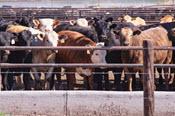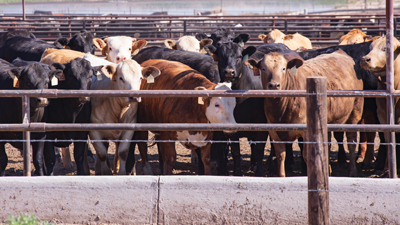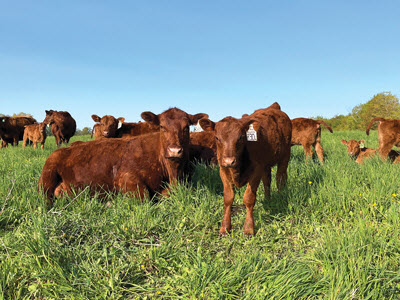
By Richard Kamchen
Beef producers have chosen cashing-in over rebuilding their herds in the wake of record cattle prices in 2023.
“There are no signs of herd expansion, and the cow herd continues to shrink,” says Brian Perillat, agribusiness specialist at More Than Just Feed.
Persistent drought remains a big concern, as do potential feed and water shortages in 2024, and high prices made the decision to sell an easier one, he says.
More heifers to feedlots
Ryan Copithorne, a rancher and owner of Cows in Control, notes more heifers are heading to feedlots in both the U.S. and Canada.
Heifers as a percentage of cattle on feed in the U.S. reached a 20-year high of 40 per cent in fall 2023, and Canada has run at a similar pace, he says.
“In Canada, we are around 30 to 35 per cent heifers, which is still high, but understates the true percentage of beef heifers on feed, as much of our supply these days is imported dairy and dairy cross steers,” Copithorne says. “If we backed out the imported steer numbers, the ratio of beef heifers as a percentage of total cattle on feed would likely be as high as the U.S. or higher.”

Drought
It should come as no surprise that drought is one of the biggest reasons behind producers not holding back heifers.
Alberta and Saskatchewan, worst hit by drought in 2023, are Canada’s largest cattle producing provinces, representing nearly 80 per cent of the national cattle inventory.
Alberta’s agriculture department in late 2023 reported long-running moisture deficits causing dwindling surface water supplies and poor growth in both native and planted perennial species. Moisture deficits in the province occurred in much of its southern, central and Peace Regions, with all of them having moisture deficits on tracts of land that occur less than once in 50 years.
Similarly, Saskatchewan’s Water Security Agency reported hot and dry conditions throughout summer and fall, resulting in most areas of the province going into winter with soil moisture that’s below to well-below normal.
Surface water supplies are at risk in the southwest if winter snowfall is below average, and, in some cases, above-normal snowpack is necessary to avoid extremely dry conditions, the agency said.
Feed
Feed represents the highest input cost for many livestock operations, and drought had the effect of deteriorating pasture conditions and lowering volumes of local cereal feeds. Many producers were forced to either transport purchased feeds and forages or wean calves and cull cattle instead.
Copithorne says pastures and water systems are tired or depleted from drought, and that many ranchers are looking to give their pastures a rest and let them rejuvenate.
He also points to a shortage of forage and grasslands.
“So much land has been converted to other uses that forage and grasslands are at a premium and hard to find,” Copithorne says. “It’s hard to expand if you can’t find grazing lands or feed to expand on.”
Perillat says the open and mild fall and the potential of El Niño to exacerbate 2023’s drought added to farmers’ worries about what’s in store for next year’s grazing season, and receiving adequate runoff to replenish watering holes, which continued to get lower or dried out completely last fall.
Anne Wasko, market analyst for Gateway Livestock Exchange, says farmers will need to see more than just the odd timely rain in 2024 to change their minds about retaining heifers.
“Herd decisions are generally made once a year for the following year, so decisions have already been made for 2024,” she says. “Rains need to happen next year for different decisions to be made for 2025 and beyond.”
Copithorne adds ranchers are hesitant to expand until their weather concerns are alleviated. But he anticipates they’ll be rewarded once they do.
“The markets I believe will be there to be worth their while for several years if they can navigate through the tight feed conditions,” he says.
Capturing high prices
Also contributing to heifers moving to feedlots has been their high values after seven years of flat prices, Copithorne says.
He recalls back when ranchers built their numbers in the strong bull market of 2014 to 2015 and were punished for it in 2016 when prices collapsed. They feared the same could happen again, so instead cashed in, paid off old debts, and cleaned up their balance sheets, Copithorne says.
“Bred heifers are averaging $3,500 when they used to be $1,800; heifer calves are $1,800 when they used to be $1,000,” he points out, adding the starting cost to keep heifers or build cows has risen. “With people liquidating drought cows, it is nearly the same purchase cost to buy a cow that will guarantee you a calf the first year as a heifer calf that will take two years to materialize a calf.”
Copithorne adds that high interest rates caused interest expenses to become a major factor in heifer development costs. The Bank of Canada’s overnight policy shot up from 0.25 per cent in January 2022 to five per cent in July 2023.
“You’re over $300 a head in interest expense alone by Year 2 of raising a heifer calf into a cow,” Copithorne says.

Shawn Cabak, Manitoba Agriculture’s forage and livestock specialist, says that when prices for calves are high, maximizing calf sales is a sound strategy to capture profits.
If a producer instead tried building a cow herd now, there would be no guarantee of selling the extra calves at 2023-like highs because they couldn’t be sold for two years at the earliest, Cabak says. And a lot can happen to cattle markets in two years.
He anticipates there will still be heifers retained, by producers who want to maintain their cow numbers but not necessarily increase them – part of normal culling practices and improving the cow herd.
“Reducing the culling rate now is a way of calving a few more cows and being able to sell those calves next year at hopefully still-high prices,” Cabak says. “This works best if culling was current up to now and the overall cow herd is younger.”
Supply crunch
Other factors behind heifers going to feedlots include demographics and labour shortages.
“The average age of a farmer is near 60, and older farmers don’t like calving heifers anymore. It is a young person’s game,” Copithorne says.
Cabak agrees that farmers close to retirement aren’t looking to expand, and says the high prices they’ve seen induced them to cut back and sell.
As for labour, Copithorne says finding people is challenging, and the shortages are stymieing those farmers who want to expand their operations or grow their herds.
As a result of all these issues, North American supply conditions are extremely tight, and will remain that way until 2026 – at minimum, he says.
“It takes two years to develop heifers into cows, and we haven’t even begun to hold heifers back, so we know this supply crunch will last until at least 2026 before herds can get built up,” Copithorne says. “This is much different than in the 2014 to 2016 period when good weather and markets created a rapid herd rebuilding that materialized by 2016.”
Similarly, the U.S. is also looking at a scenario that contrasts sharply from 2016’s. At that time, U.S. cattle for slaughter increased by 1.6 million head. Fast-forward to today and Copithorne says the U.S. is projected to lose roughly one million head a year until 2026, or roughly the equivalent of one billion pounds of beef production per year. BF



Post new comment